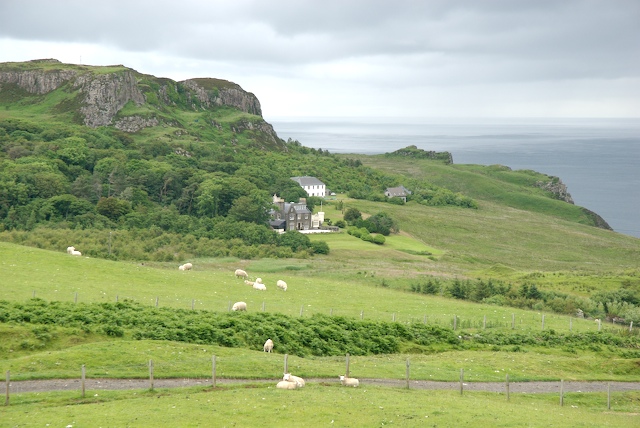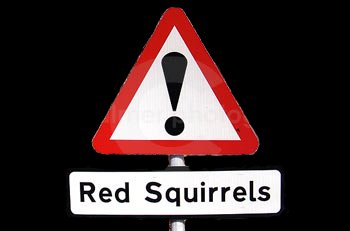
Scotland has thousands of little places with wonderful names. Typical place names are something like ArghAnGlichLochKinDrubhBlonk. Here's how I think these place names came about. Imagine a lovely little glen somewhere in the Scottish highlands, say a thousand years ago. Angus and Jock have found this place, and are sitting around their peat fire, eating their traditional ancient Scottish meal of haggis and kippers and porridge and nachos...
Angus: Och! Jocko, I ken th't this here be a great bonnie place. W'at dae ye think?
Jock: Aye
Angus: Weel then, let's g'i it a name. Whit wud ye call it?
Jock (choking on a Kipper bone): ArghAnGlichLochKinDrubhBlonk
Angus: Great! That's a guid name.
... and that's how I think these places were named.
In recent times, the Scottish tourist industry has come upon a scheme to capitalize on these lovely place names
Lets say you run the Scottish tourist industry, and you have some towns that are, oh, less than great tourist attractions. Suppose you name the town something like, say ArghAnGlichLochKinDrubhBlonk.
Now some tourists visit the town, and are less than thrilled. When they get home, and talk about their Scottish vacation with their friends and colleagues, the only thing they'll be able to say will be "We went to this really horrible little town, where the hotels were crummy, the scenery was boring, the food was disgusting, and there was a really heavy mist all the time.". When their friends ask for the name of the place to avoid, they reply "Some name that no human being can utter, or remember.". The Scottish tourist industry has an even more diabolical scheme. They find a crummy town, and call it some name like ArghAnGlichLochKinDrubhBlonk, then they find a nice, pretty, enjoyable place to go, and call it something like ArghAnGlichLochKinDrubhBlink. Note the similarity. Then, if somebody raves about ArghAnGlichLochKinDrubhBlink to their friends, people might still go to ArghAnGlichLochKinDrubhBlonk by mistake, giving the latter place some of the prestige of the former. This, of course, depends on people remembering these names, and being able to pronounce or spell them, which of course, is impossible.
I think it would be wonderful to live in a place named Haigh of Urr, or Pickletillium. Just think of the fun every time you had to tell your address to somebody on the phone.
 It is necessary that I talk about Scottish
castles. Why is it necessary? If you travel in Scotland, you are
going to see castles. Lots of them. Scotland has castles, like the
U.S. has Hamburger Joints. Here's a list of the castles we visited
during our three week trip...
It is necessary that I talk about Scottish
castles. Why is it necessary? If you travel in Scotland, you are
going to see castles. Lots of them. Scotland has castles, like the
U.S. has Hamburger Joints. Here's a list of the castles we visited
during our three week trip...
Edinburgh Castle, Stirling Castle, Doune Castle, Dorlin Castle, Castle Duntulum, Castle Dunvegan, Castle Eilean Donan, Castle Urquhart, Castle Inverness ,Cawdor Castle, Huntly Castle, Leith Hall, Crathis Castle, Drum Castle, Craigievar Castle, Castle Dunnottar, Glamis Castle, Balmoral, St. Andrews Castle, Castle Caerlaverock, Castle Cardoness
... and there were a lot that we bypassed on our way. Castles in Scotland vary a lot. Some are just ruins. Some are old real castles, built in the 12th through 16th centuries as defensive places. Some are what I consider "fake" castles, built in the 1800's as mansions for rich people, designed to look like an old castle, but never needed for defense. Some are mixtures of old parts and new parts. Except for the ruins, most are filled with beautiful antique furniture, paintings, tapestries, room decorations, fireplaces, etc. etc. Almost all require you to pay an entrance fee. That makes sense, since they all require a lot of expensive upkeep. We discovered, almost too late, that there are ways to save a lot on the entrance fee, if you expect to visit a lot of castles. Some of them offered multi-day passes, which were too confusing for us. They allowed entrances into certain castles, for a certain number of days, out of another number. Like 3 days out of 7, or 7 out of 15. We never bothered to figure out how this scheme worked. We later found out that almost all the castles in Scotland are run by one of two organizations. The National Scottish Trust, and Historic Scotland. They allow people to become members, which, among other things, entitles you to free entry into any of their properties. We discovered, after visiting several castles, that the National Scottish Trust would allow my wife and I to become members for the price of 48 pounds for a year for both of us. This was because we are seniors. This is about 100 dollars, as of this writing. This sounds like a lot, but we had figured out that entry into each castle was costing about 8 pounds per person. That's 16 pounds for the two of us. If we went to three castles, we would be even, and any other castles would be free. We joined, and used the membership many more times and saved quite a bit. Later, at the end of the trip, we discovered that the National Scottish Trust had a reciprocal arrangement with other national trusts, and we could have saved even more. I don't know if the National Scottish Trust has such an arrangement with Historic Scotland, but if it does, we could have visited virtually all the castles and other historic properties just using our membership.
One peeve I have with the National Scottish Trust is that they don't allow photography inside any of their properties. As a serious photographer, I am increasingly annoyed by the places that don't allow photography. Many more places are forbidding it. They claim that this prohibition is for the preservation of the artifacts, but that's ridiculous. I would understand if they forbade flash photography, as light is harmful to old art and antiques, and some of the more enlightened organizations do just forbid flash, but forbidding all photographs is just a greedy way to sell more postcards.
Anyway, back to Castles. One interesting fact about our visits to these castles, every time we got to a castle, it rained. Oops, I mean it misted, heavily. No matter what the weather, overcast, partly cloudy, partly sunny, or even those rare occasions when it was actually sunny, when we got to the castle, heavy mist started to fall. The prettier the castle, the heavier the mist. This is due to my curse. Did I mention that I was cursed?
Let me explain "The Kravitz Curse". I have been a serious photographer for many years. When I say serious, I mean serious. I used to use a medium-format (that means big negatives) camera, black-and-white film, and did all my own developing and printing in a darkroom. I recently switched to Digital, but I still do my own printing, and have lots of expensive equipment. Since my job unfortunately doesn't involve photography, I take most of my pictures when I travel on vacation. During the many years I have done this, it has invariably rained whenever and wherever I travel with my camera. In fact, it only rains when I am in a picture-worthy situation. If I go inside a restaurant to eat lunch, the sun comes out. If a place I am visiting is overcast and rainy for my entire stay, the sky will clear to beautiful blue as soon as I get on the plane to leave. I have even thought of turning my curse into a business -- selling my services to places that are having a drought. For a suitable (read - exorbitant) fee, I will travel to the drought-stricken location with my camera. This will cause an immediate end to the drought. Of course, it will work even better if the parched location has anything photogenic. If I take out my camera to capture something truly photogenic, a downpour is guaranteed.
Before I married my wife, I never mentioned the curse to her. I'm not sure she would have married me if she knew.
Anyway, during our trip to Scotland, the curse was in full force.
 While driving around Scotland, we did encounter
some interesting flora and fauna (no, those are not two barmaids
from Inverness, they were Flory and Fiona). One experience was very
harrowing. In fact, I'm not sure we have recovered yet. We were
driving along another beautiful Scottish road, when we encountered
something that rocked us to the very core. It was a sign. No, not
some kind of evil portent. I mean a road sign.
While driving around Scotland, we did encounter
some interesting flora and fauna (no, those are not two barmaids
from Inverness, they were Flory and Fiona). One experience was very
harrowing. In fact, I'm not sure we have recovered yet. We were
driving along another beautiful Scottish road, when we encountered
something that rocked us to the very core. It was a sign. No, not
some kind of evil portent. I mean a road sign.

Both of us were taken aback. We started glancing right and left to the sides of the road. My knuckles turned white. Perspiration covered our brows. There must be something really bad about red squirrels that we didn't know about. Fortunately for us, we never actually saw a red squirrel, but were on our guard from that point on. After a few days, we started to think that we had been having some kind of hallucination, until we saw the dreaded sign again on another road. The red squirrels were everywhere! There was nowhere to hide.
The story gets worse. Today, back in lovely Westchester County, New York, in the U.S. of A, I was stopped at a traffic light about a mile from our home, when to my horror, I saw a dreaded red squirrel in a neighbor's yard. Forget the traffic light -- I gunned the engine and burned rubber out of there. I don't think it saw me. Maybe I escaped. I probably won't sleep well now for weeks. Could they have followed me here, all the way from Scotland? You readers, take heed! Be warned! None of us may be safe. Keep watching! Keep looking down!
There was another road sign that we saw in Scotland that wasn't very scary, just very, very confusing. It was another triangular sign, but this time with no humongous exclamation point. Just a silhouette of a sheep. Ordinarily, one would assume that this was attempting to warn us that there might be sheep loose in the area. There was only one problem with that. We had been driving for weeks, and we had encountered hundreds of thousands of sheep. Everywhere. There was not a mile of road anywhere where you couldn't see sheep. On the hills. In the dales. In the valleys. Alongside the roads. In the roads. On the mountains. In people's back yards. In people's front yards. If one was an alien from outer space, one would have to come to the natural conclusion that Scotland was populated by sheep, with a smattering here and there of Scots. So why, in one particular spot, did the Scots deem it necessary to put up a sign warning us that there might be sheep? My only explanation is that we might have been in the geographical middle of the country, and this sign, being in the middle, applied to the whole country. It was saying "Warning. Scotland has sheep".
Copyright © 2007 by Jeff Kravitz
Copyright © 2007 by Jeff Kravitz